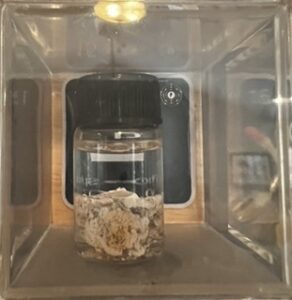Phosphorus
Atomic Number: 15
Atomic Mass: 30.973762 u

Phosphorus, an essential element in both biology and industry, was first discovered by the German alchemist Hennig Brand in 1669. The discovery took place in Hamburg, where Brand, while searching for the elusive Philosopher’s Stone, was experimenting with large quantities of human urine. He boiled it down, expecting to create gold, but instead stumbled upon a glowing, waxy substance that caught fire spontaneously when exposed to air. This substance was phosphorus, named after the Greek word “phosphoros,” meaning “light-bearer,” due to its ability to glow in the dark.
Modern Uses
Phosphorus is crucial in many modern applications. It exists mainly in two forms: white phosphorus and red phosphorus, each with distinct uses.
- Fertilizers: The most significant modern use of phosphorus is in the form of phosphate fertilizers, which are critical for modern agriculture. Phosphorus is a key nutrient for plant growth, promoting root development and improving crop yields. It plays a central role in the food production process, supporting the global agricultural system.
- Detergents: Phosphates are also used in some detergents, though environmental concerns have led to a reduction in their use due to the harmful effects of excess phosphorus on aquatic ecosystems, leading to algae blooms.
- Matches and Fireworks: The element is a key component in safety matches. The strike pad contains red phosphorus, which ignites when rubbed against the match head, allowing for safe and controlled fire-starting. Phosphorus is also used in fireworks for creating bright flashes of light and vibrant colors.
- Steel Production: It is used in metallurgy, particularly in the steel industry, to improve the strength and durability of certain steel alloys.
White Phosphorus
White phosphorus, a highly reactive and dangerous form of the element, has a long history of both beneficial and controversial uses. It is a soft, waxy solid that ignites spontaneously in air at around 30°C (86°F). Due to its pyrophoric nature, it is stored underwater or in inert atmospheres to prevent accidental ignition.
Industrial Uses:
White phosphorus is used industrially in the production of phosphoric acid, which is a precursor to various chemicals, including fertilizers and detergents. However, due to safety and environmental concerns, its use in consumer products has declined over the years.
Military Use and Controversy:
One of the most contentious uses of white phosphorus is in military applications. It is used in smoke grenades and shells to create thick clouds of smoke for signaling or concealing troop movements. However, it is also used as an incendiary weapon, which has led to significant ethical concerns due to the severe burns and injuries it can cause in combat scenarios. International laws regulate the use of white phosphorus, particularly in civilian areas, though its use in warfare remains controversial.
In summary, phosphorus, discovered centuries ago, plays a vital role in our modern world, from agriculture to industry. Its highly reactive form, white phosphorus, exemplifies both the element’s potential for utility and the need for careful handling due to its dangerous properties.
 using WordPress and
using WordPress and
No responses yet